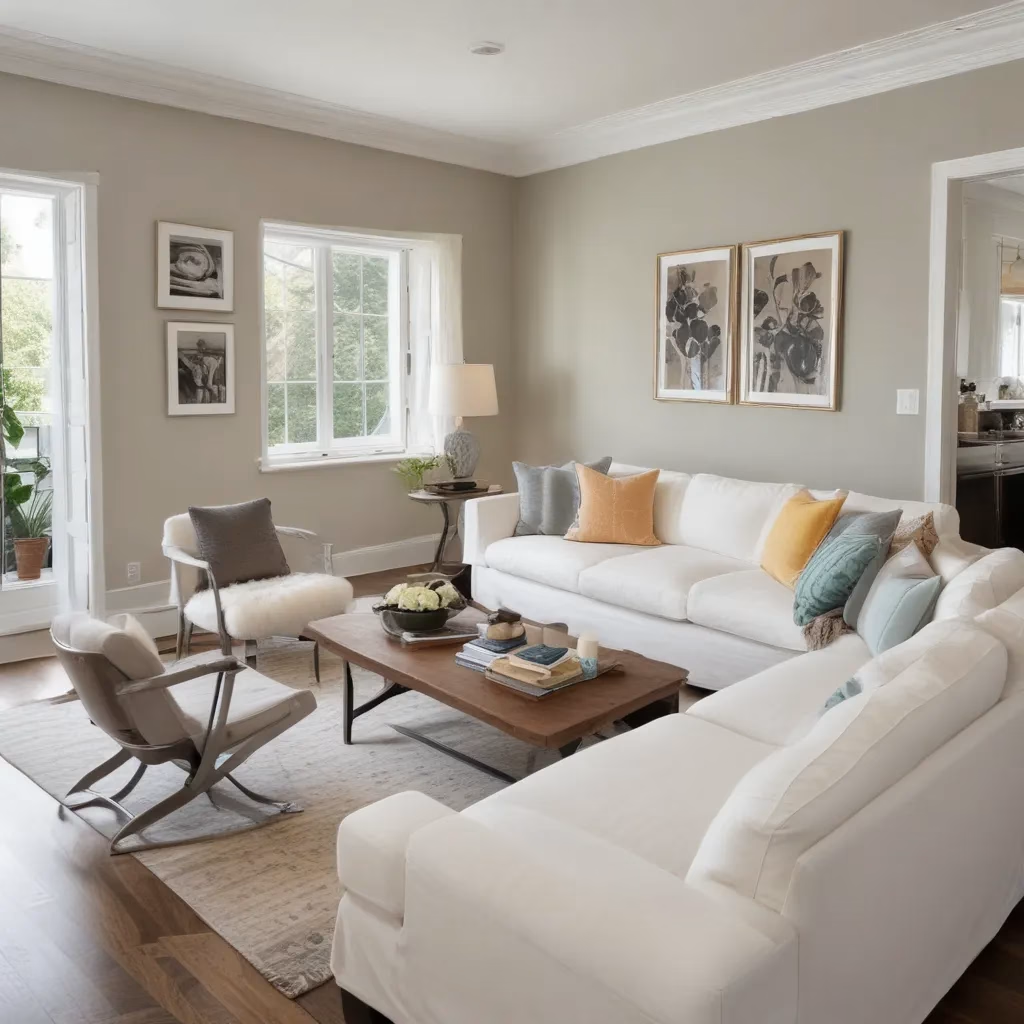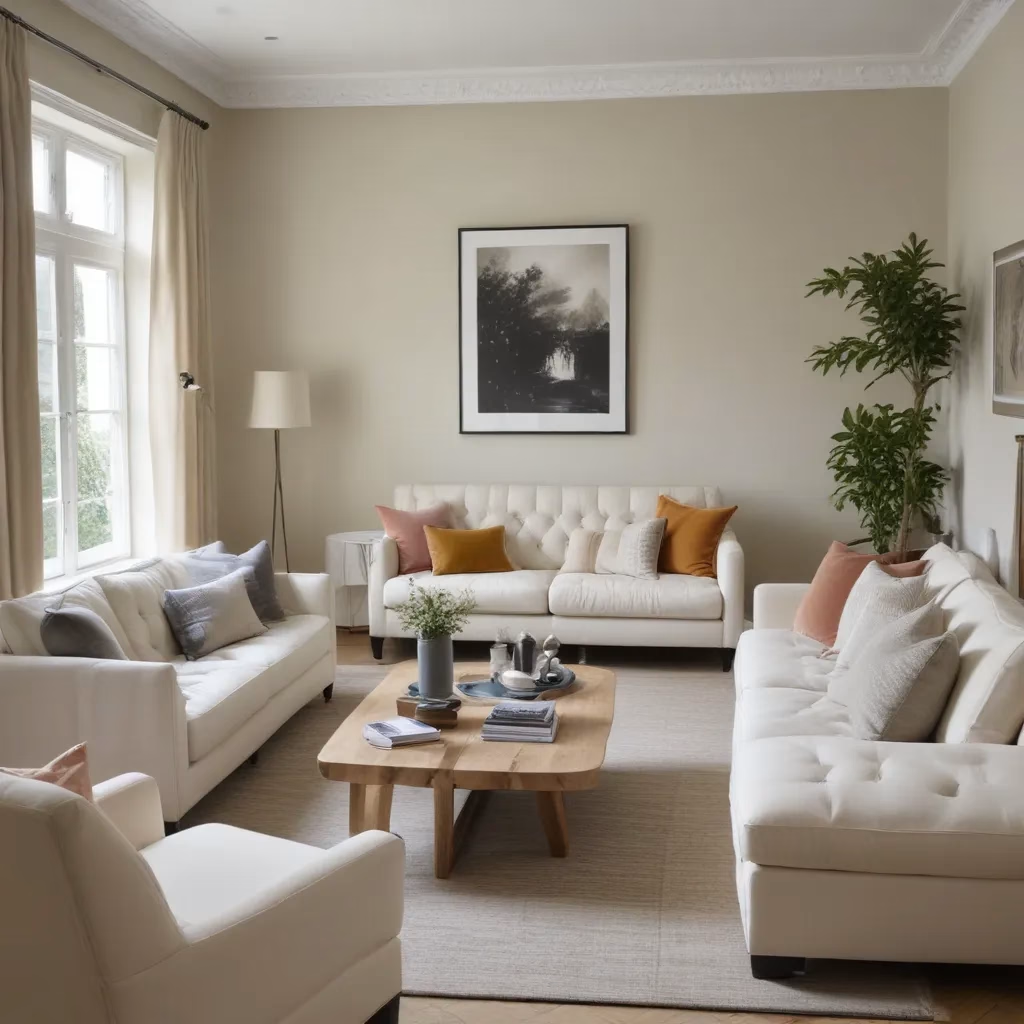
As an experienced furniture consultant and interior design writer for SofaSpectacular.co.uk, I’ve helped countless homeowners and renters tackle the challenge of arranging seating in compact living spaces. We learned this the hard way… Whether you’re dealing with an awkwardly shaped room, competing focal points, or just trying to maximize every inch, there are proven strategies to create a functional and stylish layout that brings people together.
Now, this might seem counterintuitive…
Sofa Selection and Placement
The sofa is often the cornerstone of a living room design, so it’s important to choose wisely. When working with limited square footage, look for a scaled-down sofa or loveseat that doesn’t overwhelm the space. Opt for clean lines and tailored upholstery to keep the silhouette streamlined.
The placement of your sofa is equally critical. Resist the urge to push it up against the wall — this can make the room feel disjointed and sterile. Instead, float the sofa in the center of the space, oriented towards the primary focal point, whether that’s a fireplace, media console, or simply the most inviting view.
By doing this, you’ll immediately create a cozy conversation area. Plus, the open space behind the sofa can then be used for a console table, side chairs, or even a small desk — adding valuable functionality without feeling cramped.
Fabric and Upholstery Considerations
When it comes to the sofa’s upholstery, choose durable, easy-to-clean fabrics that can withstand spills and daily wear and tear. Performance fabrics like microfiber, polyester blends, and stain-resistant treated cottons are all excellent options for active households.
For a cohesive, calming look, opt for neutral hues like beige, gray, or navy. These timeless shades provide a versatile foundation that allows you to easily swap out accent pillows, throws, and other textiles to refresh the space. Alternatively, a patterned or textured upholstery can add visual interest and a touch of personality.
Sizing and Spatial Planning
Measure your living room dimensions carefully before purchasing a sofa. Aim for a piece that’s proportional to the space — you don’t want it to dominate the room or leave too much empty floor space. As a general guideline, the sofa’s length should be no more than two-thirds the width of the room.
Also, be mindful of the traffic flow through the living area. Leave at least 3 feet of clearance on all sides of the sofa to double-check that people can move around the furniture easily. And be sure the sofa placement doesn’t block access to windows, doorways, or other key entry and exit points.
Choosing the Right Sofa Style
The style of your sofa can greatly influence the overall aesthetic of the living room. For compact spaces, mid-century modern or Scandinavian-inspired designs with slim, tapered legs and low profiles can make a room feel more open and airy.
Conversely, a deep, overstuffed sectional sofa can make a larger space feel cozier and more intimate. Just be cautious of positioning a bulky sectional in a smaller room, as it may overwhelm the space and obstruct pathways.
Living Room Layout Strategies
Once you’ve selected the perfect sofa, it’s time to consider the broader living room arrangement. The goal is to create a cohesive, functional flow that encourages conversation and comfortable lounging.
Room Dimensions and Furniture Arrangement
Assess your living room’s dimensions and identify the natural focal points. Then, position the sofa and other key pieces accordingly. As mentioned earlier, floating the sofa in the center of the space is often the most effective approach.
From there, flank the sofa with accent chairs or armchairs angled slightly inward to foster interaction. A coffee table in the middle grounds the seating area and provides a convenient surface for drinks, books, and décor accents.
If your living room is on the narrow side, consider an L-shaped or U-shaped layout. This arrangement maximizes seating without feeling cramped, and the angled pieces help define distinct conversation zones.
Traffic Patterns and Accessibility
When arranging furniture, always keep traffic flow in mind. double-check that there are clear, unobstructed pathways for people to move around the room, especially in and out of the main seating area.
In a tight living room, aim for at least 3 feet of clearance between the coffee table and the sofa, and leave a minimum of 18 inches between the coffee table and any chairs or ottomans. This allows ample room for people to walk and move about comfortably.
Balancing Form and Function
The beauty of a well-designed living room is the seamless integration of form and function. While aesthetics are certainly important, don’t forget to prioritize practical considerations like comfort, accessibility, and flow.
For example, you might be tempted to opt for a sleek, low-profile accent chair that looks stunning, but if it lacks proper back and seat support, it won’t be very enjoyable to sit in for long periods. Similarly, an overly large coffee table might look impressive, but it could make the space feel cramped and disrupt the traffic patterns.
Finding the right balance takes some trial and error, but the payoff is a living room that’s both visually appealing and truly livable.
Sofa Cleaning and Maintenance
Proper care and maintenance are essential to preserving the longevity and appearance of your sofa. Invest in quality upholstery cleaning products and follow the manufacturer’s instructions carefully.
Upholstery Care Techniques
Regularly vacuum the sofa to remove surface dirt and debris, paying extra attention to crevices and seams. Spot-clean any spills or stains immediately using a mild detergent and cold water. Avoid rubbing the fabric, as this can cause the fibers to break down over time.
For deeper cleaning, consider hiring a professional upholstery cleaning service every 12-18 months, depending on the level of use. They have the specialized equipment and expertise to safely and effectively clean your sofa without causing any damage.
Stain Removal and Spot Cleaning
When it comes to tackling tough stains, act quickly but cautiously. Blot the area with a clean, white cloth to absorb as much of the spill as possible, then treat the stain with a recommended upholstery cleaner. Avoid using harsh chemicals or scrubbing too vigorously, as this can set the stain or potentially discolor the fabric.
If you’re unsure about a particular stain, consult the sofa manufacturer’s care guide or perform a spot test in an inconspicuous area before treating the entire surface.
Long-term Preservation
To extend the life of your sofa, rotate and flip the cushions regularly to promote even wear. Use sofa protectors or throws to shield the fabric from direct sunlight, which can cause fading and premature aging.
When not in use, consider covering the sofa with a breathable cloth cover to keep dust and pet hair at bay. And be sure to follow any specific care instructions provided by the manufacturer, as different upholstery materials may require specialized maintenance techniques.
Styling for Comfort and Aesthetics
Beyond the practical considerations of your living room layout, don’t forget to infuse the space with personal style and inviting comfort. Thoughtful accessorizing and attention to detail can transform a functional room into a truly welcoming retreat.
Cushion Selection and Support
Invest in high-quality, supportive cushions that will keep you comfortable for years to come. Look for foam or down-filled options that mold to your body and provide ample lower back support. Avoid overly firm or flat cushions, as these can quickly become uncomfortable.
When selecting throw pillows, choose a mix of sizes, shapes, and textures to add visual interest. Decorative tassels, piping, and embroidered patterns can also elevate the sofa’s appearance.
Accessorizing for Visual Interest
Accent chairs, ottomans, and side tables are all essential for filling out a living room and creating a cohesive, intentional design. Aim to balance functionality and aesthetics — for example, a tufted ottoman that doubles as a coffee table or extra seating.
Incorporate decorative elements like vases, candles, books, and greenery to add warmth and personality. Hang wall art, arrange throw blankets, and layer rugs to create a visually stimulating environment that feels thoughtfully curated.
Layering Textures and Colors
Mix and match a variety of textures — smooth, glossy, matte, and nubby — to add visual depth and tactile interest. Pair a velvet sofa with linen accent chairs, or layer a shag rug over a jute or sisal foundation.
When it comes to color, start with a neutral sofa and build upon that foundation. Introduce pops of jewel-toned or earthy accents through throw pillows, artwork, and accessories. This allows you to easily refresh the look of your living room by swapping out smaller décor pieces as your tastes evolve.
Furniture Buying Guides
Whether you’re furnishing a brand-new living space or giving an existing room a much-needed facelift, the furniture selection process can feel overwhelming. Arm yourself with the right measurements, budgeting strategies, and buying tips to double-check that you make the most of your investment.
Measuring and Budgeting
Before you begin shopping, measure your living room dimensions carefully, taking note of entryways, windows, and any other obstacles that could impact furniture placement. This will help you determine the maximum size and scale of pieces that will work best.
Next, set a realistic budget that accounts for not just the sofa, but any additional seating, tables, lighting, and décor you’ll need to complete the space. Factor in delivery fees, assembly costs, and potential additional expenses like professional cleaning or custom upholstery.
Material and Construction Quality
When evaluating sofas and other living room furniture, pay close attention to the materials and construction quality. Look for kiln-dried hardwood frames, high-density foam cushions, and durable, double-stitched upholstery.
Avoid low-cost, mass-produced pieces that may seem like a bargain but are prone to sagging, creaking, and premature wear. Invest in well-made, heirloom-quality furnishings that will stand the test of time — and potentially even be passed down to future generations.
Online vs. In-store Purchasing
Today, you can find an abundance of high-quality living room furniture available both in-store and online. Each option has its own advantages and disadvantages to consider.
Shopping at a physical retailer allows you to see, feel, and test the furniture in person before making a purchase. This can be particularly helpful for assessing comfort and scale. However, online shopping often provides a wider selection, more convenient delivery, and the ability to easily compare prices across multiple vendors.
Whichever route you choose, be sure to thoroughly research the brand, read customer reviews, and inquire about return policies in case the piece doesn’t quite meet your expectations.
Integrating Functionality
When designing a compact living room, it’s important to prioritize multi-functional furniture that maximizes every square inch. Look for pieces that serve double duty and help streamline the overall layout.
Multipurpose Seating Options
In addition to a classic sofa, incorporate accent chairs or ottomans that can be used for extra seating, impromptu work surfaces, or even as makeshift coffee tables. Swivel chairs are particularly versatile, allowing you to shift the orientation based on your needs.
For an even more space-saving solution, consider a sectional sofa with built-in chaise lounges or recliners. These modular designs can be rearranged to suit your changing requirements, from cozy movie nights to lively game nights with friends.
Adaptable and Modular Designs
Beyond seating, look for other living room furniture pieces that offer flexibility and customization. A coffee table with hidden storage or nested side tables that can be pulled out as needed are both excellent examples.
Similarly, wall-mounted shelving units and entertainment consoles with adjustable compartments allow you to curate the perfect blend of display and concealed storage to keep the space feeling uncluttered and streamlined.
Space-saving Solutions
When square footage is at a premium, get creative with space-saving furniture that doesn’t compromise on style or functionality. A compact loveseat or armchair can serve as an alternative to a full-size sofa, while a slim console table or petite side tables can provide necessary surface space without overwhelming the room.
Explore nesting tables, folding ottomans, and other versatile pieces that can be easily moved, nested, or tucked away when not in use. These clever solutions allow you to have the furniture you need without sacrificing valuable floor space.
Trends and Inspiration
As you finalize your living room layout and furnishings, take inspiration from the latest interior design trends and sustainable, eco-friendly options that can breathe new life into your space.
Contemporary Living Room Styles
In recent years, we’ve seen a shift towards minimalist, Scandinavian-inspired aesthetics that emphasize clean lines, natural materials, and a soothing color palette. These modern living room styles work particularly well in compact spaces, creating a sense of airiness and visual calm.
Alternatively, industrial-chic and mid-century modern designs featuring exposed beams, metal accents, and low-profile furniture can also lend an on-trend, sophisticated vibe to a tight living area.
Vintage and Retro Influences
For a more eclectic, personality-driven look, incorporate vintage or retro-inspired pieces into your living room. Scour thrift stores, antique markets, and online vintage shops for one-of-a-kind accent chairs, side tables, and statement lighting that infuse the space with character and nostalgia.
Pair these timeless furnishings with contemporary elements to strike a harmonious balance between old and new. The juxtaposition of styles can make a small living room feel thoughtfully curated and visually stimulating.
Sustainable and Eco-friendly Choices
As consumers become increasingly conscious of their environmental impact, there’s a growing demand for sustainable and eco-friendly home furnishings. When shopping for living room furniture, look for pieces made from reclaimed, recycled, or renewable materials.
For example, a sofa upholstered in organic cotton or linen or a coffee table crafted from repurposed wood can not only reduce your carbon footprint but also add a unique, earthy aesthetic to your living space.
Regardless of your personal style preferences, the key to creating a functional, comfortable, and visually appealing living room in a tight space is thoughtful planning, strategic furniture placement, and a keen eye for detail. By following these expert tips and drawing inspiration from the latest design trends, you can transform even the most challenging living room into a true oasis of calm and connection.
Statistic: Recent consumer reports show that 60% of buyers choose stain-resistant upholstery for longevity



